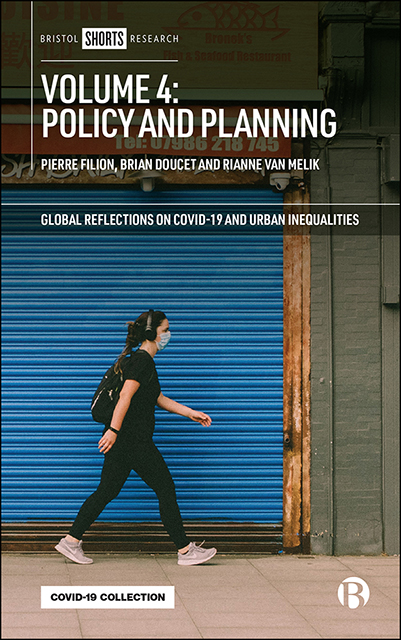66 results
Index
-
- Book:
- Volume 2: Housing and Home
- Published by:
- Bristol University Press
- Published online:
- 13 April 2023
- Print publication:
- 22 July 2021, pp 205-213
-
- Chapter
- Export citation
Part IV - Age, Race, Gender, and Ability
-
- Book:
- Volume 1: Community and Society
- Published by:
- Bristol University Press
- Published online:
- 13 April 2023
- Print publication:
- 22 July 2021, pp 185-186
-
- Chapter
- Export citation
Contents
-
- Book:
- Volume 3: Public Space and Mobility
- Published by:
- Bristol University Press
- Published online:
- 25 April 2023
- Print publication:
- 22 July 2021, pp v-viii
-
- Chapter
- Export citation

Volume 4: Policy and Planning
-
- Published by:
- Bristol University Press
- Published online:
- 25 April 2023
- Print publication:
- 22 July 2021
Index
-
- Book:
- Volume 3: Public Space and Mobility
- Published by:
- Bristol University Press
- Published online:
- 25 April 2023
- Print publication:
- 22 July 2021, pp 219-229
-
- Chapter
- Export citation
Frontmatter
-
- Book:
- Volume 2: Housing and Home
- Published by:
- Bristol University Press
- Published online:
- 13 April 2023
- Print publication:
- 22 July 2021, pp i-iv
-
- Chapter
- Export citation
Twenty-Two - Conclusion
-
-
- Book:
- Volume 1: Community and Society
- Published by:
- Bristol University Press
- Published online:
- 13 April 2023
- Print publication:
- 22 July 2021, pp 245-250
-
- Chapter
- Export citation
Notes on Contributors
-
- Book:
- Volume 3: Public Space and Mobility
- Published by:
- Bristol University Press
- Published online:
- 25 April 2023
- Print publication:
- 22 July 2021, pp xi-xv
-
- Chapter
- Export citation
Acknowledgments
-
- Book:
- Volume 1: Community and Society
- Published by:
- Bristol University Press
- Published online:
- 13 April 2023
- Print publication:
- 22 July 2021, pp xvii-xvii
-
- Chapter
- Export citation
List of Figures and Tables
-
- Book:
- Volume 4: Policy and Planning
- Published by:
- Bristol University Press
- Published online:
- 25 April 2023
- Print publication:
- 22 July 2021, pp ix-x
-
- Chapter
- Export citation
Preface to All Four Volumes of Global Reflections on COVID-19 and Urban Inequalities
-
- Book:
- Volume 2: Housing and Home
- Published by:
- Bristol University Press
- Published online:
- 13 April 2023
- Print publication:
- 22 July 2021, pp xv-xxii
-
- Chapter
- Export citation
Contents
-
- Book:
- Volume 1: Community and Society
- Published by:
- Bristol University Press
- Published online:
- 13 April 2023
- Print publication:
- 22 July 2021, pp v-viii
-
- Chapter
- Export citation
Frontmatter
-
- Book:
- Volume 1: Community and Society
- Published by:
- Bristol University Press
- Published online:
- 13 April 2023
- Print publication:
- 22 July 2021, pp i-iv
-
- Chapter
- Export citation

Volume 1: Community and Society
-
- Published by:
- Bristol University Press
- Published online:
- 13 April 2023
- Print publication:
- 22 July 2021
List of Figures
-
- Book:
- Volume 3: Public Space and Mobility
- Published by:
- Bristol University Press
- Published online:
- 25 April 2023
- Print publication:
- 22 July 2021, pp ix-x
-
- Chapter
- Export citation
Notes on Contributors
-
- Book:
- Volume 1: Community and Society
- Published by:
- Bristol University Press
- Published online:
- 13 April 2023
- Print publication:
- 22 July 2021, pp xi-xvi
-
- Chapter
- Export citation
Part II - Life During Lockdown
-
- Book:
- Volume 1: Community and Society
- Published by:
- Bristol University Press
- Published online:
- 13 April 2023
- Print publication:
- 22 July 2021, pp 71-72
-
- Chapter
- Export citation
Frontmatter
-
- Book:
- Volume 4: Policy and Planning
- Published by:
- Bristol University Press
- Published online:
- 25 April 2023
- Print publication:
- 22 July 2021, pp i-iv
-
- Chapter
- Export citation
One - Introduction
-
-
- Book:
- Volume 3: Public Space and Mobility
- Published by:
- Bristol University Press
- Published online:
- 25 April 2023
- Print publication:
- 22 July 2021, pp 1-12
-
- Chapter
- Export citation
Preface to All Four Volumes of Global Reflections on COVID-19 and Urban Inequalities
-
- Book:
- Volume 4: Policy and Planning
- Published by:
- Bristol University Press
- Published online:
- 25 April 2023
- Print publication:
- 22 July 2021, pp xix-xxvi
-
- Chapter
- Export citation

